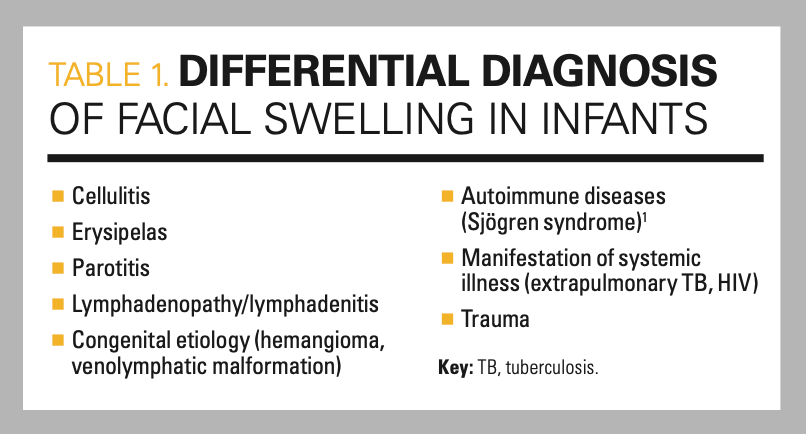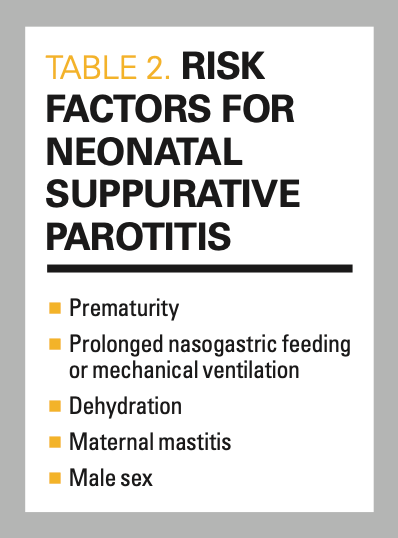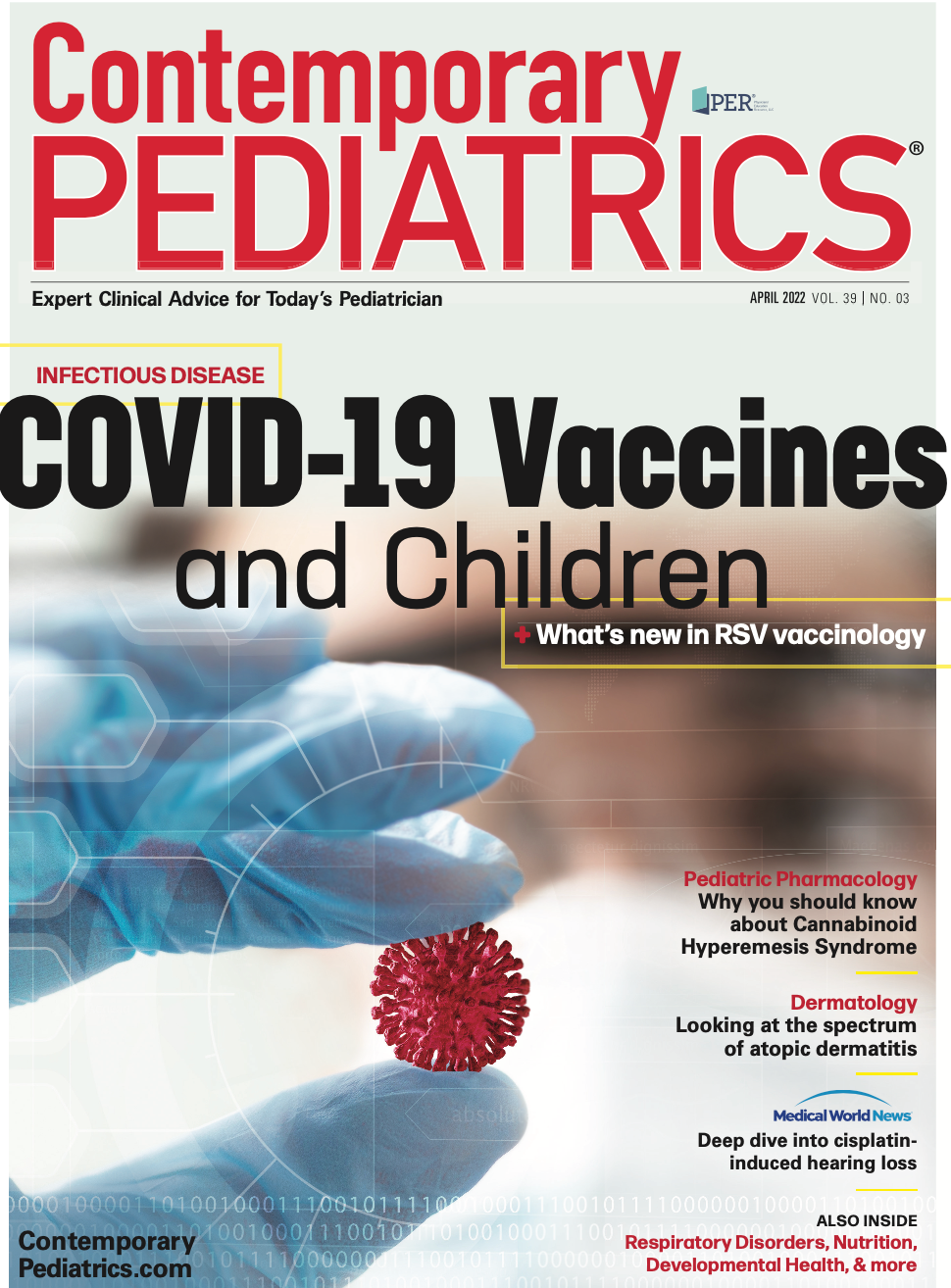Fever and facial swelling in a neonate
An 18-day-old girl whose right cheek had become increasingly red and warm over 24 hours was directly admitted to an inpatient unit. She had firmness and pain to the affected area, fussiness, increased sleeping, and poor feeding, preferring the bottle to breastfeeding. What's the diagnosis?
The case
An 18-day-old girl whose right cheek had become increasingly red and warm over 24 hours was directly admitted to a pediatric inpatient unit from an outpatient pediatric office. In the office, the infant, born full term via an uncomplicated vaginal delivery, was febrile, with a rectal temperature of 100.6°F. She had firmness and pain to the affected area, fussiness, increased sleeping, and poor feeding, preferring the bottle to breastfeeding.

The infant did not have cough, changes in bowel movements, abdominal distention, emesis, or decreased urination, and she had no recent sick contacts or history of facial trauma. Her mother did not have mastitis. The family had a dog, but there was no direct contact between the pet and the patient. The patient’s father was a veterinarian and her mother worked at a local hospital.
The infant’s vital signs on admission included rectal temperature of 101.2°F; heart rate, 152 beats per minute; respiratory rate, 46 breaths per minute; and oxygen saturation, 98% on room air. A physical exam demonstrated a well-developed neonate who was irritable but alert and active. The anterior fontanelle was flat, and her head was normal size, without signs of trauma. The conjunctiva were clear, without injection or tearing, and the tympanic membranes were normal bilaterally. The infant did not have rhinorrhea, and her oropharynx was without erythema or exudates. Her right cheek was swollen, firm, erythematous, and warm to the touch.
There was no fluctuance, crepitus, or drainage. Cardiovascular and respiratory examinations were unremarkable. The infant’s abdomen was soft, with normoactive bowel sounds and no evidence of distention. Complete blood cell count, basic metabolic panel, and C-reactive protein (CRP) levels were obtained along with urine blood and cerebral spinal fluid (CSF) cultures due to concern for a possible disseminated infection in a neonate. CSF Gram stain, cell count, and meningitis/encephalitis panel were normal. White blood cell count was 21,600/μL, and CRP was 92 mg/L.
Differential diagnosis
For this patient’s facial swelling, differential diagnosis included cellulitis, erysipelas, congenital malformations, and neonatal parotid gland enlargement. Infectious etiologies included mumps; extrapulmonary tuberculosis (TB); or, more commonly, suppurative parotitis. Less common conditions were tumor and autoimmune conditions such as Sjögren syndrome1 (Table 1). Due to concern for suppurative parotitis as the etiology in this newborn, empiric intravenous (IV) clindamycin and cefotaxime were started for broad- spectrum coverage.
Table 1

On hospital day 1, an ultra- sound of the right cheek was per- formed to evaluate for abscess. The right parotid gland was enlarged (2 × 1.2 × 1.5 cm), with inhomogeneous echotexture and preserved flow without evidence of an abscess. Pus was expressed from the parotid duct and sent for culture. These findings combined with the patient’s clinical picture suggested an acute infectious/inflammatory process within the right parotid gland, consistent with parotitis.
Discussion
Suppurative parotitis is a rare condition in children and neonates. The pathophysiology is thought to be due to ascending bacterial organisms from the oropharynx colonizing the parotid gland.2 As seen in this patient, the common clinical presentation includes fever, erythema, and swelling of the preauricular area with or without fluctuance.3 A variety of risk factors have been identified (Table 2) and include situations that promote stasis in the salivary glands, such as dehydration and nasogastric tube feeding. Interestingly, male sex has been associated with a 3-fold increased risk of parotitis, although the reason remains unclear.3
Table 2

In cases of unilateral facial swelling, clinicians must maintain a broad differential diagnosis including cellulitis, lymphadenitis, and traumatic injury, with special attention to potentially life-threatening conditions, such as retropharyngeal, peritonsillar, or oral abscess.
Importantly, suspected suppurative parotitis in neonates must be interpreted in the context of the increased risk of sepsis in infants.3 As such, it is important to collect blood, urine, and CSF cultures to evaluate for systemic infection. The vast majority of neonatal parotitis cases are caused by gram-positive cocci, with Staphylococcus aureus being the most commonly isolated organism. However, case series have identified anaerobes as well as gram-negative bacilli such as Escherichia coli and Klebsiella pneumoniae.3,5
Initial treatment involves IV broad-spectrum antibiotics such as a third- or fourth-generation cephalosporin. Classically, the diagnostic criteria for parotitis include facial swelling, purulent exudate expressed from the parotid gland, and positive cultures. However, when the diagnosis is unclear or there is no obvious parotid exudate, ultrasound can help evaluate for the presence of abscess and need for surgical drainage. Some cases may call for other imaging to identify congenital anomalies or laboratory work to assess for other infectious etiologies such as HIV, TB, or mumps.
Case outcome
The patient had rapid clinical improvement with significant reduction in erythema and swelling. On hospital day 2, IV antibiotics were discontinued, and she was discharged to complete 7 days of oral cephalexin. At 48 hours, salivary duct and blood cultures grew methicillin-sensitive S aureus that was susceptible to cephalosporins but resistant to clindamycin. Two weeks after discharge, the child’s symptoms had resolved, and she was progressing well. It remained unknown to the pediatrics team how this infant obtained the infection, given her lack of obvious risk factors.
References
1. Stiller M, Golder W, Döring E, Biedermann T. Primary and secondary Sjrögen’s syndrome in children—a comparative study. Clin Oral Investig. 2000;4(3):176-182. doi:10.1007/s007840000070
2. Miranda A, Pereira KD. Neonatal suppurative parotitis. Ear Nose Throat J. 2010;89(10):488-489.
3. Spiegel R, Miron D, Sakran W, Horovitz Y. Acute neonatal suppurative parotitis: case reports and review. Pediatr Infect Dis J. 2004;23(1):76-78. doi:10.1097/01.inf.0000105181.74169.16
4. Ismail EA, Seoudi TM, Al‐Amir M, Al‐Esnawy AA. Neonatal suppurative parotitis over the last 4 decades: report of three new cases and review. Pediatr Int. 2013;55(1):60-64. doi:10.1111/j.1442-200X.2012.03738.x
5. Ryan, RF, Padmakumar B. Neonatal suppurative sialadenitis: an important clinical diagnosis. BMJ Case Rep. 2015:bcr2014208535. doi:10.1136/bcr-2014-208535
